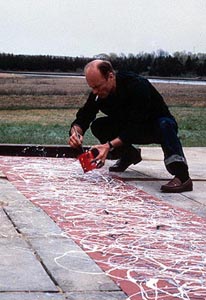![[Metroactive Movies]](http://metroactive.com/movies/gifs/movies468.gif)
[ Movies Index | Show Times | San Jose | Metroactive Central | Archives ]
Drip to Bountiful
Ed Harris 'Pollock' never quite penetrates the impasto of the artist's life
By Richard von Busack
NOW THAT everyone worships him as a dead art saint, no one will connect Jack the Dripper's penchant for public urination with his talent for splashing paint. In Pollock, director/title star Ed Harris re-creates the way action painter Jackson Pollock spread drips and splatters onto canvases of still-breathtaking harmony.
The paintings themselves often exonerate Pollock's turbulent, self-destructive life. He was not just the most celebrated American artist of his age, he was also the most self-hating: a corrosive, battling drunk who acted like a rock star on a bender.
The fictional Pollock describes well the mid-1940s art scene--back-stabbing, hardscrabbling, the audience barely existent, the market practically nil. It portrays how the ruthlessness of this scene turned inward on the artists. Unfortunately, the film doesn't go far enough in showing us what tormented Pollock himself.
Pollock makes the artist's long-suffering wife, Lee Krasner, into a saint, too. Marcia Gay Harden's performance is so strong that the film ought to have been called Pollock and Krasner. Harden delivers one especially powerful scene: her furious response to Pollock's suggestion that they have a baby. She's smart enough to understand she's already burping and diapering her husband full-time.
Amid the conflict between Pollock and Krasner, the other performers come across as incidental. Harris' real-life wife, Amy Madigan, plays Peggy Guggenheim in a visual range that stretches from Mrs. Nosferatu to Lady Bird Johnson.
It was only after reading about Guggenheim's treatment of her stable of artists that I learned why someone might want to pee in her fireplace, as Pollock did. Guggenheim pioneered the financial advance that needed to be paid off (or repaid) from profits, the same technique that the recording industry has used to break down so many musicians. Guggenheim was essentially the only game in town for abstract artists during the mid-1940s.
Much of the film is spent waiting for Mt. Pollock to blow up, although the lyrical moments hold your attention. Early on, Krasner lures Pollock into her bedroom. Not since Crush have we seen the sensual side of Harden. She undresses in the shadows at the end of a hallway. We can't see her body, just her silhouette, but we can hear the clicks and snaps of her clothing coming undone.
The painting scenes give us Harris at his best. Some of these moments are in the league of H.G. Clouzot's documentary The Mystery of Picasso, which showed the artist at work. Early on, as Pollock constructs the mural for Guggenheim's apartment, there's a me-and-my-shadow scene of him pacing in front of the giant blank space he proposes to fill.
Similarly exhilarating is the "eureka!" moment after Pollock trudges off to his studio in the snow. He heads out wordlessly to the unheated room like a man on his way to the coal mine. After stocking a pitifully small potbellied stove and putting on some music, Pollock studies and studies his canvas. He lays down a crooked stripe of silver radiator paint as broad as duct tape and suddenly notes a curlicue drip on the floor. Later, Krasner's congratulations--"You've done it, Pollock. You've cracked it wide open"--show us the vicarious pleasure of hitting pay dirt.
Harris' Pollock is both virile and terrified, a stag in the headlights. He's compelling but too calculating. Pollock lights a cigarette in the time it would take most people to go out for a pack of smokes.
ALTHOUGH Pollock never goes wrong in the usual ways of an artist's biography, there's something missing, even baffling, in the movie. You try to read between the lines, but there's not always material there to be prized out. Harris feels so much sympathy for Pollock's silences that he never goes up against them. The mystery of Pollock is never peeled back.
Pollock's bisexuality, with which he wrestled all his life, may have been reason for his drinking and bullying. Pollock's trysts with men are one part of the story Harris banned, presumably because modern movie audiences couldn't deal with it.
We've seen rock musicians, writers and more than a few artists tearing up the screen in the throes of their creative torment. Here was the opportunity to show a different kind of torment: the story of how a macho artist, married, beer drinking, kind to his pet raven and his pet dog, felt like he wasn't really straight and couldn't stand it. Harris is a commanding actor, serious and intense, but as a director he backed off from the most unusual part of the story. As a result, his often striking movie is a lock without a key.
[ San Jose | Metroactive Central | Archives ]
Copyright © 2001 Metro Publishing Inc. Metroactive is affiliated with the Boulevards Network.
For more information about the San Jose/Silicon Valley area, visit sanjose.com.
![]()
 Splatter Film: Ed Harris indulges the tantrums and terrors of action-painting icon Jackson Pollock (Harris himself) in his bio-flick 'Pollock.'
Splatter Film: Ed Harris indulges the tantrums and terrors of action-painting icon Jackson Pollock (Harris himself) in his bio-flick 'Pollock.'
Pollock (R; 122 min.), directed by Ed Harris, written by Susan Emshwiller and Barbara Turner, based on the biography by Steven Naifeh and Gregory White Smith, photographed by Liza Rinzler and starring Ed Harris and Marcia Gay Harden, opens Friday at the at the Guild in Menlo Park and at the Los Gatos Cinema in Los Gatos.
From the February 22-28, 2001 issue of Metro, Silicon Valley's Weekly Newspaper.